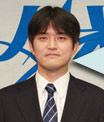JAXA Astronaut Activity Report, August 2009
Last Updated: October 14, 2009
This is JAXA's Japanese astronaut primary activity report for August 2009.
ASCAN Training Course at NASA Begins

Astronaut candidates Yui (left) and Onishi (right) during the opening ceremony of the ASCAN training course
JAXA's astronaut candidates Mr. Yui and Mr. Onishi visited the United States to enroll in the astronaut candidate (ASCAN) training organized by NASA.
Astronaut candidates Mr. Yui and Mr. Onishi, along with astronauts from other international partners of the International Space Station (ISS) program, attended the opening ceremony of the ASCAN training course held at NASA’s Johnson Space Center (JSC) and made speeches on their aspirations for the training. The two astronaut candidates will continue training at NASA for about 2 years.
After the opening ceremony, they participated with the other ASCAN members in wilderness survival training at the US navy facility in the State of Maine.

Astronaut Candidate Mr. Onishi participating in survival training (second from back)

Astronaut Candidate Mr. Yui participating in survival training (front)
The purpose of this training is to learn survival skills when waiting for rescue, in case of an anomaly and emergency exit during the T-38 training flight, in which they will participate in the future.
The training included orientation practice using maps and compasses, first-aid treatment for the injured, how to prepare shelters using parachutes and rain gear, and how to make fire, as well as strengthening teamwork among the new ASCAN members.
ISS Expedition Operations Training in Russia

Astronaut Noguchi during reentry training (©JAXA/GCTC)
Expedition 22/23 crew member Astronaut Noguchi and his backup, Astronaut Furukawa, participated in training sessions on the Russian ISS module and the Soyuz TMA spacecraft at the Gagarin Cosmonaut Training Center (GCTC) in Russia.
Training for the Soyuz TMA spacecraft included manual rendezvous/docking operation, manual reentry, and simulation of the increased gravity during reentry and decent using the centrifuge accelerator. Training on the Russian module of the ISS included an emergency drill in case of fire. Other activities included fittings for the Sokol spacesuit to be worn in the Soyuz TMA spacecraft and the cold weather suit to be worn in case of emergency landing.

Astronaut Noguchi entering the centrifuge accelerator (©JAXA/GCTC)
In addition, Astronaut Noguchi reviewed the structure and layout inside the Soyuz spacecraft and participated in training on the docking systems of the ISS’s Russian module.
The training period in Russia was open to the media, which showed the training session using the centrifuge accelerator and the manual maneuvering training of the Soyuz spacecraft.

During the press conference
The astronauts also held a press conference. Astronauts Noguchi, referring to his flight aboard the Soyuz spacecraft to the ISS, said that getting involved in the manned spacecraft, including the training, is part of Japan’s technological accumulation. Because he will be the first person from JAXA to have hands-on experience in Soyuz operation, this will be another new step. He expressed his wish that this leads to aspiration for developing of Japan’s own manned spaceflight vehicles. Astronaut Furukawa said that he has been learning a great deal and that the Soyuz spacecraft is known for its credibility. He hopes that he can contribute to Japan’s future space development by accumulating such expertise.
SRMS Operations Training

Astronaut Yamazaki (right) operating the SRMS on the simulator
Astronaut Yamazaki participated in operation training on the space shuttle's Remote Manipulator System (SRMS) at NASA's Johnson Space Center (JSC) in preparation for the STS-131 mission.
Using the simulator, she operated the SRMS to return the Orbiter Boom Sensor System (OBSS) to the starboard side of the space shuttle's payload bay.
Astronaut Yamazaki and NASA Astronaut Stephanie Wilson alternated roles as the crew member operating the SRMS and the supporting crew member monitoring the display and overboard.









